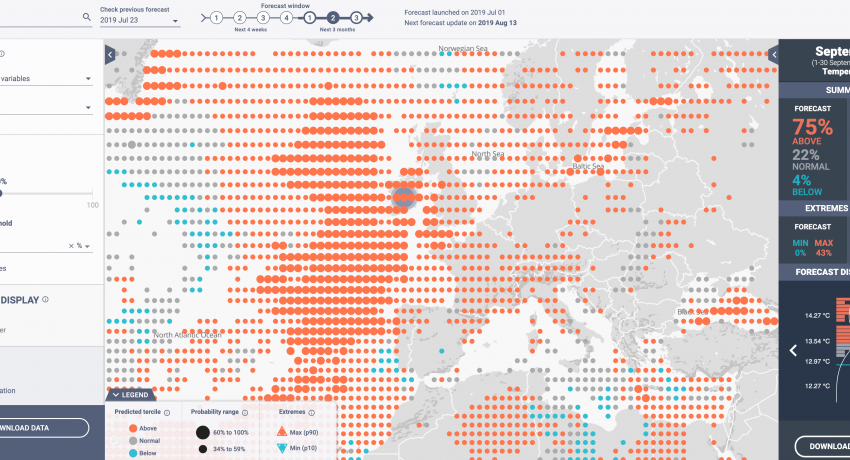The Sub-seasonal to Seasonal Prediction Project (S2S) is a joint research initiative from 2013, whose main goal is to “improve forecast skill and understanding of the subseasonal to seasonal timescale, and to promote its uptake by operational centres and exploitation by the applications communities.”
The July edition of the S2S Newsletter dedicated its “Special articles” section to an article about the S2S4E project, written by Albert Soret Miravet (the S2S4E coordinator) and Julia Cannata (Project Dissemination Officer) at the Barcelona Supercomputing Center. This 2-page article, included below, features the project itself, the added value of sub-seasonal and seasonal forecast for the energy sector, the process to create the online Decision Support Tool (DST), S2S4E forecasts and its availability, and the research behind S2S4E.
S2S4E: customising sub-seasonal and seasonal forecasts for the needs of energy user
Albert Soret and Julia Cannata-Barcelona Supercomputing Center
The added value of sub-seasonal and seasonal forecasts for the energy sector
The energy industry has traditionally used climatology to anticipate renewable energy sources and electricity demand for situations 15 days or more into the future. However, assuming that future conditions will be similar to average past conditions has several inherent shortcomings. EU-funded S2S4E (Sub-seasonal to Seasonal climate forecasting for Energy) aims to address these shortcomings by demonstrating the potential application of sub-seasonal to seasonal forecasts. These forecasts will enable renewable energy producers and providers, electricity network managers and policy makers to design better informed strategies to: manage resources effectively, anticipate resource effects on markets, plan for maintenance works (especially offshore wind), anticipate cash flow and optimize return on investments, anticipate colder and hotter periods or schedule power plants to reinforce supply (Soret et al. 2019).
The S2S4E process
To customise forecasts and ultimately co-create the Decision Support Tool (DST; s2s4e.eu/dst) that would effectively be used and useful to energy users, a two-step process was carried out. First, S2S4E worked with energy companies to identify relevant case studies of past unusual climate behaviour. These events were analysed with sub-seasonal and seasonal forecasts to evaluate the added value, including the economic benefits, that climate predictions could have provided to energy users in the context of these case studies. The second major step of S2S4E involved working side-by-side with users to integrate the sub-seasonal and seasonal forecasts into the DST. As a result of this close collaboration between industry and research S2S4E has been able to launch an operational and online tool that provides visually the climate information and customisable features that energy users have indicated would be beneficial.
S2S4E forecasts and its availability
The online DST therefore includes climate information determined to be specifically relevant to renewable energy production -- solar power, hydropower, wind power, and demand. This includes post-cessed sub-seasonal (updated every week) and seasonal (updated every month) climate predictions of solar radiation, solar capacity factor, inflows, precipitation, seal level pressure, annual snow max, wind speed, wind speed capacity factor, temperature, maximum and minimum temperature, and electricity demand. In its current version, the DST is integrating ECMWF SEAS5 seasonal forecasts from the Copernicus Climate Data Store and the sub-seasonal predictions of CFSv2 system through NCEP database. S2S4E is one of the projects participating in the real time pilot initiative of S2S, that will allow to make use of S2S models to produce tailored forecasts and to assess their added value continuously in a real business environment with the feedback of the industry partners.
The research behind S2S4E
The development of the project is composed by two complementary research lines. The first research line consists of exploring the frontiers of sub-seasonal and seasonal predictions taking into account user needs. For instance, a majority of climate prediction studies focus on variables such as temperature. However, S2S4E extends its research to other climate variables, such as wind speed. Taking this variable as example, S2S4E has: 1) assessed which global reanalysis best represents winds comparing them with instrumented tall towers (Ramon et al. 2019); 2) characterized European wind speed variability for the whole year using weather regimes computed month by month, addressing the user's need of a service that covers all year, since most studies focus on winter season only. (Cortesi et al. 2019); and 3) investigated the drivers of one of the main wind droughts in the recent years that significantly affected the energy sector (Lledo et al. 2018). The second research line is devoted to transfer this knowledge to the society and ensure the impact and application of the research. For instance, within the context of S2S4E a game has been developed, where users can play with probabilistic information and assess the usefulness of climate predictions, showing that in skillful areas economic benefits are obtained in the long term (Terrado et al. 2019).
Take advantage of the S2S4E DST
Ultimately, the co-generation process of this decision tool has achieved both a closer and stronger engagement with the users as well as enhanced reliability of the DST, to result in a platform which can be used for effective decision-making. To encourage usage of the tool and improve its features, it will be open and freely available until November 2020 in s2s4e.eu/dst.
References:
Cortesi, N., V., Torralba, N., González-Reviriego, A., Soret, and F.J., Doblas-Reyes (2019). Characterization of European wind speed variability using weather regimes. Climate Dynamics, doi:10.1007/s00382-019-04839-5
Lledó, Ll., Bellprat, O., Doblas‐Reyes, F. J., & Soret, A. (2018). Investigating the effects of Pacific Sea Surface Temperatures on the Wind Drought of 2015 Over the United States. Journal of Geophysical Research: Atmospheres, 123, 4837– 4849. doi:10.1029/2017JD028019
Ramon, J. , Lledó, L. , Torralba, V. , Soret, A. and Doblas‐Reyes, F. (2019), What global reanalysis best represents near surface winds?. Q J R Meteorol Soc. Accepted Author Manuscript. doi:10.1002/qj.3616
Soret, A., Torralba, V., Cortesi, N., Christel, I., Palma, Ll., Manrique-Suñén, A., Lledó, LL., González-Reviriego, N., and Doblas-Reyes, F.J. (2019). Sub-seasonal to seasonal climate predictions for wind energy forecasting,J. Phys.: Conf. Ser.,1222, doi:10.1088/1742-6596/1222/1/012009
Terrado, M., Lledo, LL., Bojovic, D., St. Clair, A.L., Soret, A., Doblas-Reyes, F.J., Manzanas, R., San-Martín, D., Christel, I., The Weather Roulette: a game to communicate the usefulness of probabilistic climate predictions. Bulletin of the Americal Meteorological Society. Accepted
Written by Julia Cannata / BSC.


